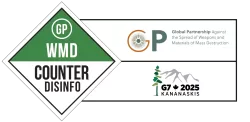What is Nuclear Weapon and Radiological Weapon Disinformation?
Disinformation in the nuclear and radiological security realm is a rapidly growing threat, capable of creating confusion, fear, and potentially dangerous policies that can destabilize the international system and escalate crises.
In 2016, false reports claimed that U.S. tactical nuclear weapons were being moved from Turkey to Romania. Widely disseminated by state-affiliated media and presented as evidence of provocations, this misinformation highlights how false claims can manipulate public perception and influence policy decisions.
A more recent example involves Russia’s false accusations that Ukraine plans to detonate a “dirty bomb” on its own soil. Similarly, Russian officials and state media have falsely accused Ukraine of seeking to develop nuclear weapons, alleging the existence of stockpiles of uranium or plutonium, secret facilities, and Western assistance. These unfounded allegations are used to frame Ukraine as a nuclear threat, justify military actions, escalate tensions, undermine international support for Ukraine, hinder peaceful resolution efforts, and increase regional instability.
The rapid spread of disinformation is accelerated by social media and AI-generated content, which are particularly vulnerable due to the high volume and speed of information dissemination. Addressing this issue requires action at all levels, including public education to enhance media literacy, organizational commitment to data accuracy, and transparency.
The Global Partnership Against the Spread of Weapons and Materials of Mass Destruction is developing tools to counter nuclear and radiological weapons disinformation, particularly as it arises in Ukraine. These efforts are vital to creating a safer, more secure world.
